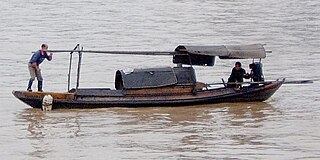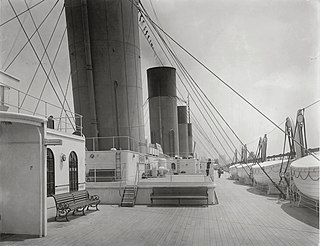
A boat is a watercraft of a large range of types and sizes, but generally smaller than a ship, which is distinguished by its larger size, shape, cargo or passenger capacity, or its ability to carry boats.

A sampan is a relatively flat-bottomed Chinese and Malay wooden boat. Some sampans include a small shelter on board and may be used as a permanent habitation on inland waters. The design closely resembles Western hard chine boats like the scow or punt. Sampans are generally used for transportation in coastal areas or rivers and are often used as traditional fishing boats. It is unusual for a sampan to sail far from land, as they do not have the means to survive rough weather.
Fair Haven Beach State Park is a 1,141-acre (4.62 km2) state park on the southeastern shore of Lake Ontario in upstate New York. It is located on the east side of Little Sodus Bay in the town of Sterling in Cayuga County, northeast of the village of Fair Haven. The southern part of the park is sometimes called Fair Haven State Park.

An ice shantycabane à pêche (fr) is a portable shed placed on a frozen lake to provide shelter during ice fishing. They can be as small and cheap as a plastic tarp draped over a frame of two-by-fours, or as expensive as a small cabin with heat, bunks, electricity, and cooking facilities.

Vernacular architecture is building done outside any academic tradition, and without professional guidance. It is not a particular architectural movement or style, but rather a broad category, encompassing a wide range and variety of building types, with differing methods of construction, from around the world, both historical and extant and classical and modern. Vernacular architecture constitutes 95% of the world's built environment, as estimated in 1995 by Amos Rapoport, as measured against the small percentage of new buildings every year designed by architects and built by engineers.

A cottage, during England's feudal period, was the holding by a cottager of a small house with enough garden to feed a family and in return for the cottage, the cottager had to provide some form of service to the manorial lord. However, in time cottage just became the general term for a small house. In modern usage, a cottage is usually a modest, often cosy dwelling, typically in a rural or semi-rural location and not necessarily in England. The cottage orné, often quite large and grand residences built by the nobility, dates back to a movement of "rustic" stylised cottages of the late 18th and early 19th century during the Romantic movement.

A deck is a permanent covering over a compartment or a hull of a ship. On a boat or ship, the primary or upper deck is the horizontal structure that forms the "roof" of the hull, strengthening it and serving as the primary working surface. Vessels often have more than one level both within the hull and in the superstructure above the primary deck, similar to the floors of a multi-storey building, that are also referred to as decks, as are certain compartments and decks built over specific areas of the superstructure. Decks for some purposes have specific names.
Steerage is a term for the lowest category of passenger accommodation in a ship. In the nineteenth and early twentieth century, considerable numbers of persons travelled from their homeland to seek a new life elsewhere, in many cases North America and Australia. Many of those people were destitute in their homeland and had the minimum of resources to procure transportation. The term later widened to imply the lowest category of accommodation on a passenger vessel.

A mountain hut is a building located high in the mountains, generally accessible only by foot, intended to provide food and shelter to mountaineers, climbers and hikers. Mountain huts are usually operated by an Alpine Club or some organization dedicated to hiking or mountain recreation. They are known by many names, including alpine hut, mountain shelter, mountain refuge, mountain lodge, and mountain hostel. It may also be called a refuge hut, although these occur in lowland areas too.

A bothy is a basic shelter, usually left unlocked and available for anyone to use free of charge. It was also a term for basic accommodation, usually for gardeners or other workers on an estate. Bothies are found in remote mountainous areas of Scotland, Northern England, Ulster and Wales. They are particularly common in the Scottish Highlands, but related buildings can be found around the world. A bothy was also a semi-legal drinking den on the Isle of Lewis. These, such as Bothan Eòrapaidh, were used until recent years as gathering points for local men and were often situated in an old hut or caravan.
A basha is a waterproof canvas or plastic sheet with eyelets or loops on the perimeter, which is used in camping, outdoor, or military situations to act as a shelter, in the form of an impromptu tent and/or groundsheet, usually supported with rope or even bungee cords attached to trees.

A lean-to is a type of simple structure originally added to an existing building with the rafters "leaning" against another wall. Free-standing lean-to structures are generally used as shelters. One traditional type of lean-to is known by its Finnish name laavu.

A hut is a small dwelling, which may be constructed of various local materials. Huts are a type of vernacular architecture because they are built of readily available materials such as wood, snow, ice, stone, grass, palm leaves, branches, hides, fabric, or mud using techniques passed down through the generations.

Tomlinson Run State Park sits on 1,398 acres (5.7 km2) along the small Ohio River tributary of the same name. This state park lies near the foremost tip of the panhandle, in Hancock County. This is the only state park in West Virginia that offers overnight accommodations in a yurt.

A bass boat is a small boat that is designed and equipped primarily for bass fishing, usually in freshwater bodies such as lakes, rivers and wetlands. The modern bass boats are motorboats that feature an elevated flat front deck with swivel chairs that permit the angler to readily cast to any direction around the boat, large storage containers for fishing tackles and equipment such as rods, reels and lures, high-performance fishfinders, and a recirculating livewell where caught fish may be stored and kept alive for prolonged periods of time.
Philip Laing is a 19th-century sailing ship best known as the second immigrant ship to arrive in Dunedin, New Zealand, on 15 April 1848. Chartered by the New Zealand Company for this voyage the ship was carrying Scottish settlers, under the charge of the Rev. Dr. Thomas Burns.

Prawn is a common name for small aquatic crustaceans with an exoskeleton and ten legs, some of which are edible.

The Siren 17 is a Canadian trailerable sailboat, that was designed by Hubert Vandestadt as trailer sailer and first built in 1974.
The Lynx 16 is an American trailerable sailboat that was designed by Tony Davis as an daysailer and pocket cruiser, and first built in 1997.















